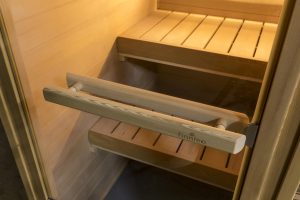For centuries, saunas have been a means of relaxation and rejuvenation. The design of these small rooms or buildings focuses on producing heat, usually 113°F to 212°F. So how can these high temperatures create a more easygoing and well-rested you?
As a Finnleo sauna dealer, Hot Spring Spas of Iowa and the Twin Cities knows first-hand the many health and wellness benefits of sauna use. Whether you’re a longtime customer or interested in learning more, we’re here to divulge what you should know about traditional and infrared saunas.
Traditional Saunas: A Classic Approach to Relaxation
Traditional saunas have a long history and deep roots in many cultures. Known for the intense heat and ability to make you sweat profusely, the high temperature stimulates blood circulation and promotes relaxation.
When it comes to sauna bathing, traditional saunas are the classic approach. They use heated rocks or a stove for heat production, warming the air in the sauna. The intense heat causes you to sweat profusely, promoting detoxification and relaxation. As you sweat, toxins are released from your body, leaving you feeling refreshed and rejuvenated. Traditional saunas also provide a social experience, as they’re often shared spaces where you can relax and unwind with others.
It’s typically made of wood, adding a natural and rustic element to the sauna experience. Though it can be built indoors, the traditional style is usually found in an outdoor setting, like a backyard or garden.
Infrared Saunas: Harnessing the Power of Heat
Infrared saunas have gained popularity in recent years due to their unique benefits. Unlike its traditional counterpart, an infrared sauna uses radiant heat to warm the body directly.
An infrared heater emits radiant heat which is absorbed directly by the body, rather than heating the air. Infrared saunas operate at a lower temperature than traditional saunas, usually around 120˚F and 140˚F. The lower temperatures make them more comfortable for people sensitive to high heat. Plus, they’re frequently made of materials like carbon fiber or ceramic, which emit infrared heat.
The heat from an infrared sauna penetrates deeper into the body, promoting increased blood flow and circulation. This can help relieve muscle tension, reduce inflammation, and provide pain relief. Infrared saunas are also known for their ability to promote relaxation and stress reduction.
Infrasaunas: A Combination of Traditional & Infrared
Infrasaunas offer the best of both worlds by combining the benefits of traditional and infrared saunas. They use heated rocks or a stove and infrared heaters. This combination allows you to experience the intense heat of a traditional sauna, along with the therapeutic benefits of infrared heat. Infrasaunas provides a customizable sauna experience, as you can adjust the temperature and heat source to suit your preferences.
Choosing Between Indoor & Outdoor Saunas
When deciding between an indoor or outdoor sauna, there are several factors to consider.
Indoor saunas offer convenience and privacy. They can be easily accessed year-round and are not affected by weather conditions. Indoor saunas also provide a cozy and intimate setting for leisure and renewal.
On the other hand, outdoor saunas allow you to enjoy nature while experiencing the benefits of sauna bathing. They can be built in your backyard or garden and provide a unique and tranquil sauna experience. Outdoor saunas also offer the option of cooling off in nature, such as taking a dip in a pool or lake after a sauna session.
Whether you prefer the convenience of an indoor sauna or the natural surroundings of an outdoor sauna, choosing the right location is essential for your sauna experience.
Common Misconceptions About Sauna Use
1. Saunas Are Only For Cold Climates.
While they’re usually associated with cold climates, saunas have been a part of various cultures, including Native American traditions, for centuries. Saunas can be enjoyed in warm and cool climates, as their health benefits aren’t limited by climate.
2. Saunas Are Expensive To Operate.
Contrary to the belief, many modern saunas, such as infrared saunas, are cost-effective to use. For example, an infrared sauna may cost less than $1 for a 15-minute session at today’s electricity rates.
3. I Can’t Put A Sauna In My House.
This misconception is outdated. Modern saunas are designed to be an integral part of a home, with various models offering sleek and stylish designs suitable for indoor use.
4. There Are No Real Health Benefits To Sauna Bathing.
Research has shown that sauna bathing is linked to various health benefits, including:
- Detoxification,
- Reduced risk of cardiovascular diseases,
- Improved cardiovascular function,
- Stress relief, and
- Pain reduction.
5. Sauna Use Isn’t Safe For Everyone
While sauna use is generally safe for most people, there are specific precautions for individuals with certain medical conditions. It’s important to consult a medical professional before using a sauna if you have conditions such as high blood pressure or heart disease, or if you’re pregnant.
How To Incorporate Sauna Use Into Your Daily Routine
Whether it’s in the morning, during a break, or before bed, a sauna session can provide a valuable opportunity for relaxation, reflection, and self-care.
Jumpstart The Day With A Morning Sauna Session
A sauna session in the morning can help stimulate blood flow, improve breathing, and provide a quiet space for stretching, meditation, or envisioning the day ahead. It can help clear the mind and prepare for a productive day.
Unwind During A Lunch Break Or At The End Of The Workday
A quick sauna session during a lunch break or at the end of the workday can help you feel relaxed and refocused. It can also serve as a reminder to stretch and relax your muscles, especially if you’ve been sitting for a long period.
Make The Sauna Part Of A Bedtime Routine
Many people benefit from sauna time before bed to help unwind, relax, and reduce stress. The warm environment can help relax tired muscles and minds, improve blood flow, and promote better sleep.
Post-Sauna Steps
After a sauna session, it’s important to rehydrate, shower to remove any accumulated salts, and moisturize the skin. You’ll continue feeling refreshed and rejuvenated throughout the day.
Incorporate Light Exercise
Incorporating light exercises, such as gentle stretching and yoga poses for balance and flexibility, can enhance mobility and contribute to a more active daily routine.
Breathe Deeply For A New Sauna Experience
Engage in breathing exercises during your sauna session to take the experience to the next level. Techniques like deep breathing can have various health benefits, from improving blood pressure and mood to reducing stress and boosting the immune system.
Relish The Peace & Quiet
Saunas provide a distraction-free environment for contemplation and relaxation. Use your sauna time as an opportunity to focus on your goals, visualize your aspirations, and enjoy a moment of peaceful introspection.
FAQs About Traditional & Infrared Saunas
What’s The Difference Between A Wet Sauna Vs. A Dry Sauna?
Humidity. A dry sauna has humidity levels between 5 and 30 percent, while a wet sauna has 100 percent humidity. The moisture comes from the heating method, usually hot stones or an electric stove, or an external steam generator.
What Should I Wear In An Infrared Sauna?
Typically, a bathing suit or underwear is ideal. It’s important to wear clothing free of plastic or metal fasteners to prevent any discomfort or potential burns.
How Often Should I Use An Infrared Sauna?
The frequency of infrared sauna use is based on individual needs, but generally, one to three sessions per week are recommended.
Can My Sauna Be Customized?
Yes! We offer a range of custom saunas. But, if you’re looking for a simpler yet customized experience, check out upgrade options such as heater upgrades, lumber options, door design, and more.
Can An Indoor Sauna Go Outdoors?
It’s generally not recommended for several reasons. An indoor sauna isn’t made to shed water or snow; has more glass than outdoor saunas; and depending on the model, may not have a proper floor.
Experience A New Level Of Relaxation With A Sauna Today
Indoor or outside, traditional or infrared, Hot Spring Spas of Iowa and the Twin Cities excels in pairing your wellness goals with the right sauna. For more than 40 years, we’ve listened and learned from our customers and strive to help you relax every day. Visit any of our six locations today to find your dream sauna!
The post The Ultimate Guide To Traditional & Infrared Saunas appeared first on Hot Tubs Minneapolis, Des Moines, Swim Spas, Saunas Sale | IA, MN.





 952-933-9040
952-933-9040 651-731-9745
651-731-9745 651-731-9745
651-731-9745